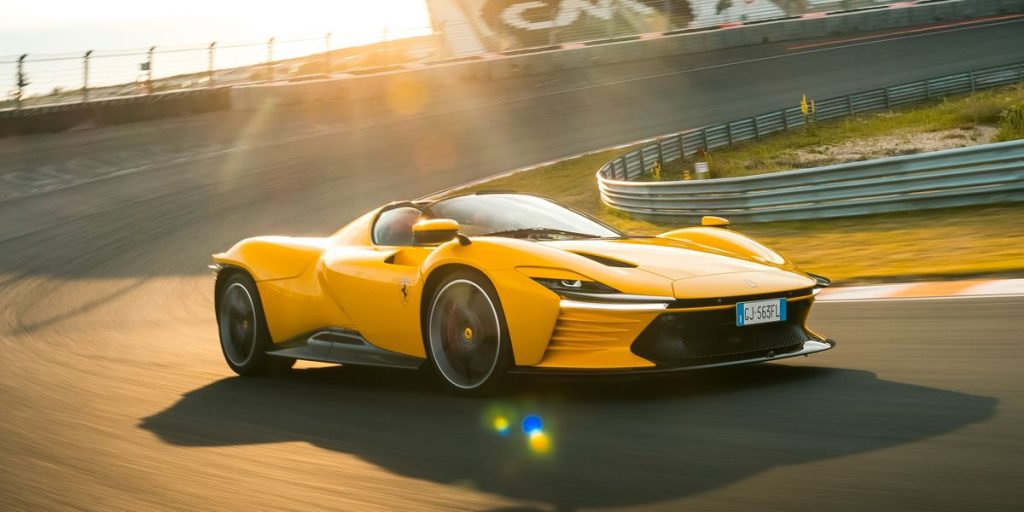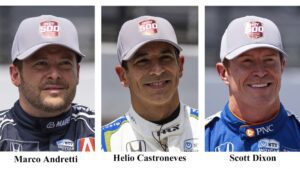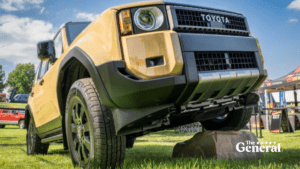2022 Ferrari Daytona SP3 Basks in Reflected Glory

As far as we’re aware, Ferrari does not have a space program. So if you’ve got space-travel-level funds, and you want to spend $2.2 million of it with the Prancing Horse marque, maybe you’re one of the excessively fortunate 599 clienti who will be purchasing a Ferrari Daytona SP3. If so, go ahead and buy a matching space suit in Rosso Corsa. We won’t judge.
The SP3 is rolling theater, and crowds form every time you stop. It is the kind of thing that commands phones to start recording and elicits excited noises from children. And you can play your part by pulling both shift paddles to temporarily select neutral, allowing you to rev the 6.5-liter V-12 to its 9500-rpm redline.
Although great art shouldn’t need rationalization, you may wonder the reasoning behind the SP3. It goes back to 1966, when Ford took first-, second-, and third-place finishes with its GT40 at both the Daytona 24 Hours and the 24 Hours of Le Mans, much of this dramatized in the film Ford v. Ferrari. It wasn’t until eight months later, back at Daytona, that Ferrari delivered its riposte and finished one-two-three with its reengineered prototypes.
The Daytona SP3, which looks back to those late-’60s race cars, is the latest in Ferrari’s Icona Series, reserved for ultra-limited-production cars inspired by standout moments in the brand’s history (the Monza SP1 and SP2 were the first Icona models). This merger of retro ’60s design with modern vehicle shapes results in bulging wheel arches, fender-placed side mirrors, a three-piece wraparound windshield, and the striking horizontal bars crossing the rear. The result looks like something out of Cyberpunk 2077.
But perhaps most impressive of all is how the SP3 eschews modern performance equipment. Sure, it features carbon-fiber bodywork and has a seven-speed dual-clutch transmission, but there are no large wings or active aerodynamic pieces, the steering is hydraulically assisted, and the 829-horsepower V-12 is free of forced induction or assist from electric motors.
The SP3’s body has its origins with the 2015 Ferrari LaFerrari and its roofless Aperta variant, sharing similar measurements for wheelbase and length. The SP3 is slightly taller due to its larger-diameter wheels (20-inch front and 21-inch rear), and it’s significantly wider at 80.7 inches—that’s even wider than a Ford F-150. Modifying the A-pillar to mimic a wraparound windshield required large changes to the structure, which like the body is made from carbon fiber. Despite the increased size, Ferrari says the SP3 is lighter than the LaFerrari, with a claimed dry weight of 3274 pounds.
Further differences continue underneath. The V-12 is derived from the engine in the 812 Competizione, but with 10 more prancing horses. That makes this V-12 the most powerful in Ferrari history, but you’ll be more impressed by the sound: a glorious shrieking wail in its upper register but also lovely in its mechanical-ness at lower revs. You can feel its inertia even under light engine braking and see its heat waves through the rearview camera. The V-12’s sound and vibration are ever present, so it’s jarring when the auto stop-start system kills it at a light. (Pro tip: Disable stop-start immediately upon firing up the SP3 by hitting the button marked HELE.)
For all the V-12 sweetness, it’s the steering that truly stands out. The hydraulically assisted rack might be the best part of the car. The wheel is stable enough that you have the confidence to maneuver it one-handed, yet it still faithfully transmits the road texture. The effort is light but so controlled that it builds immediate confidence in this rolling showpiece.
Confidence at the wheel of the SP3 is key, lest you become a highlight on someone’s social-media cringe reel. While stealing eyeballs may seem like the goal of the exterior, Ferrari designers explain a different desire: to produce the same aerodynamic performance as modern supercars, but without wings or active elements. They say they’ve succeeded, although it’s hard to imagine many of these cars will be driven quickly enough to challenge that claim. The only active bits on the exterior are the headlight covers that move up and down depending on the light setting.
The SP3’s bulging and flowing shapes help draw air over and through the body. The best part is the hood, whose curves are wonderfully free of unnecessary lines. The stack of horizontal body-color bars at the rear of the car is another dramatic element. They hide a vent that essentially spans the height and width of the SP3’s rear to help extract heat. Each bar is a unique carbon-fiber piece.
Ducts at the front of each door channel air into radiators sitting behind the quarter-panels. The width they add means you must take extreme care to avoid hitting your head when entering under the butterfly-opening doors. There’s no real way to exit gracefully either, especially for the less limber. The result makes the Daytona a wonderful car to arrive in, but one you might not want to be seen exiting. No cameras, please.
The SP3 is a short-distance car. It has no real luggage space—a shallow frunk tray accommodates a tool kit and a fabric roof for unpredictable weather (the body-color, carbon-fiber roof panel must be stored separately when removed). Buyers choose from three seat sizes and three backrest angles, and Ferrari bolts the nonadjustable seats right to the tub. In another nod to Ferrari’s ’60s-era prototype racers, fabric bridges the seats over the tunnel. The driver adjusts the pedal box forward and back for comfort and accessibility. While headroom is generous with the roof installed, passenger legroom is shallow due to the packaging of the HVAC system.
Part of our driving experience included a handful of laps at Circuit Zandvoort, home of the Dutch Grand Prix and seemingly all the Netherlands’s elevation features. Though we were limited to under 50 mph, the forward view, with the wheel arches proudly jutting up and framing the extreme banking, truly looked like the point-of-view shot you see when they’re screaming down the Mulsanne Straight in Ford v. Ferrari.
As for how the SP3 drives, the steering feel and the engine response are simply delightful, but the low-speed track access and narrow Dutch roads revealed little about how thrilling it is to drive quickly. We doubt it will come up short in that department, but one could rightfully question whether driving quickly is even the point.
The Daytona SP3 interprets a moment of Ferrari’s motorsports past through a modern lens. It looks like a spaceship and draws crowds when parked. And it will be one of the last mid-engine and naturally aspirated V-12 supercars Ferrari makes—the company won’t confirm how many are left, but it’s a short list. That it shuns some modern supercar tropes means it’s a type of vehicle that exists in fewer and fewer numbers every year, one that reminds you that you’re operating a machine—and a very special one at that.
A car-lover’s community for ultimate access & unrivaled experiences. JOIN NOW
This content is created and maintained by a third party, and imported onto this page to help users provide their email addresses. You may be able to find more information about this and similar content at piano.io



